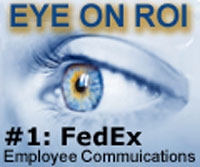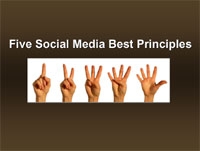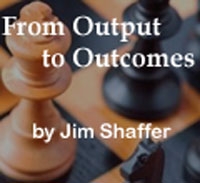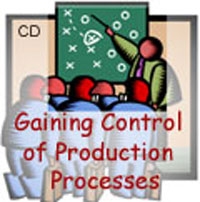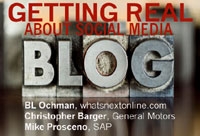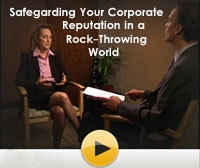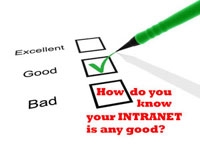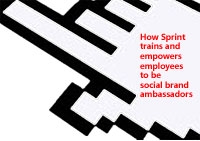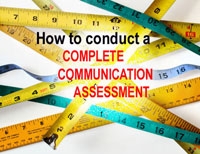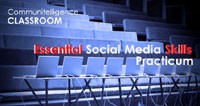How and why FedEx Employee Communications moved from focusing on creating more news to creating better business outcomes.
This webinar features Terry Simpson, head of employee communications for FedEx Express. After conducting a global communication assessment, Terry and her colleagues decided that the communication function needed to focus more on creating business outcomes rather than distributing more news. Working with FedEx Express leadership she identified and conducted a project in Los Angeles to improve US export volume through better managed communication. The result: 15% increase in volume and 23% increase in revenues with an overall 1,400 ROI.
What You Will Learn:
- How to work with senior leadership and a lot of data to identify opportunities to improve performance through better managed communication
- How to search for opportunities within the white spaces—the areas between functions and disciplines
- How to bring disparate groups together to improve performance through enhanced communication
- How to recognize root causes of performance problems
- The powerful role rewards play in communicating what’s important
- How to take a success and create an even bigger one with five more locations.
Questions that are answered:
- What’s the difference in managing communication to create output—a distribution business—and managing it to create outcomes—a solutions business?
- Is there a role for traditional communication practitioners in this process?
- What additional skills and knowledge do I need to move to this new level?
- How do I get started?
- How do I pick the right project that practically assures success?
- What’s in it for me if I make the shift? More money? More career opportunities? More fame?
- What’s the best way as a communication manager to move from output to focusing on solutions?
- What did FedEx stop doing when it embarked on this project? This goes to the question of staffing – were additions made to the department?
- Did you use any formal media channels to bolster your face-to-face solutions processes?
- Where do you go to get training to lead your department in this direction? What disciplines should you study?
- What pushback do you hear from communicators when you present this message? What’s the best way as a communication manager to move from output to focusing on solutions?
Who Should Purchase:
- Communications professionals who want to enhance their partnership and value to the business.
Instructor:
 Jim Shaffer is one of the world’s leading thought leaders, consultants and authors, helping businesses engage their people to achieve ultra-high levels of organizational performance. His book, The Leadership Solution (McGraw-Hill), has been hailed by leading CEOs as “invaluable for someone wanting to lead an organization into the future” and a “practical common-sense look at how leaders use communication to solve business problems.”
Jim Shaffer is one of the world’s leading thought leaders, consultants and authors, helping businesses engage their people to achieve ultra-high levels of organizational performance. His book, The Leadership Solution (McGraw-Hill), has been hailed by leading CEOs as “invaluable for someone wanting to lead an organization into the future” and a “practical common-sense look at how leaders use communication to solve business problems.”
Jim’s focus is on improving people performance: helping business leaders execute better by creating engaged people, who think and act like business owners. He blends his unique background in general management, product line management, organizational change and communication management and helps clients get at the root cause of people performance problems. His track record includes significant, quantifiable improvements in quality, service, costs, productivity and speed through a more engaged workforce.
Terry Simpson has worked in the Communications field for over 30 years in every area including broadcast, video, print, web sites, event management, strategy and content development. Terry is leading the change at FedEx Express and using communication solutions to solve business problems.
Simplify Your Social Media Strategies and Relations (and now….Breathe)
Q: What if you had five simple principles you could apply to all your social media initiatives instead of chasing after all those “best practices” and the coolest, newest tools, and then trying to mash them up to meet your specific situation?
A: You could confidently face your social media planning, campaigns or learning without panic, feeling overwhelmed or behind the curve.
Linda will simplify your life and arm you with just five principles that you can apply as “universal truths” in implementing social media. These five principles can act as your “check list” and be your guide whether you are trying to learn about social media, are embarking on engaging in social media relations or are building out a social media strategy. We aren’t saying you won’t have work to do afterwards, but it will be clearer what social media work is the right work.
If you ever asked yourself “how to I get started in social media?” “what social media tools should we be using?” “how do I keep up on it all?” or “how do I stop all the social media noise in my head?” purchase this webinar replay and start simplifying your life – really.
Replay
What You Will Learn:
- The difference between social media “best practices” and “best principles.”
- Why relying on best principles is better than continually searching for best practices.
- The five principles anyone can apply to be effective in doing social media relations, creating a social media strategy or learning about social media
- What is truly necessary to focus on to be successful in social media.
- Learn about at least ten resources that will simplify your social media life or learning.
- How to decide on the best social media tools to use.
- How to bring your newsroom into the social media century.
- At least one way to convince your boss on the value of using social media.
- Why you need a Creative Commons copyright license.
- How to limit the “social media” noise that can confuse you and your efforts and help you stay focused on what’s really important.
Presented by:
 Linda Zimmer is a digital media consultant and modern marketing strategist, serving an international clientele. She specializes in assisting organizations in benefiting from, managing and innovating with new media for marketing, communications and internal and external collaboration.
Linda Zimmer is a digital media consultant and modern marketing strategist, serving an international clientele. She specializes in assisting organizations in benefiting from, managing and innovating with new media for marketing, communications and internal and external collaboration.
Linda is CEO of Marcom:Interactive, sits on the Advisory Board of Web Wise Kids, and is a consulting council analyst for the Gerson Lehrman Group. She is founder of the Modern Media Institute, a professional development institute for new media practices (launching September 2008) and she regularly trains public agencies for the State of California. She currently is an advisory board member for the Extension University at California State University, Fullerton on developing Web 2.0 curriculum.
Ms. Zimmer has more than 25 years of experience in applying emerging media to organizational issues. During her career she has provided digital services to many of the Fortune 100/500 companies and Internet startups; the FDA, U.S. Forestry Services, and U.S. cities and counties; non-profits of all sizes; colleges and universities, and entertainment properties. Linda serves as a resource to the news media and she publishes extensively on the Web. (http://freshtakes.typepad.com)
If you think performance counts now, you ain’t seen nothin’ yet! Jim Shaffer, who pioneered the results-driven approach to managing communication, will explain what others have done to become indispensable to their leaders, because they are over and over again putting money in their leaders pockets. Literally! Jim’s lively and provocative CD will reveal what companies are doing to surgically shift their priorities and focus on those parts of the organization that can drive performance results most. Using real case studies, Jim will show how companies can generate two- and three-thousand-percent returns on their internal communication investments. He’ll explore the Three Stages of Organizational Communication Maturity and explain how a department can attain increasingly higher levels of operating and financial performance.
Learn How:
- FedEx, Owens Corning and others have created significant performance improvements with returns on their investments exceeding 1,400 percent
- Honeywell cut its billing cycle by 10 days and eliminated 1.4 million process steps while improving quality
- Sara Lee reduced waste by 18 percent in five weeks at one its bakeries
Learn Why:
- Dave Brown’s CEO said: “We are absolutely convinced that there’s a competitive advantage to be gained by engaging our people through better managed communication. We’ve seen it pay off already in measurable improvements in costs and productivity.”
- Owens Corning’s senior vice president of manufacturing said, “We’ll take as many 700-percent returns as we can get.”
Discussion Topics:
- Why the communication function in every business must measurably increase the value it adds—or die
- What other companies are doing about it and how they’ve moved from an output to an outcome-generating organization
- What you can do next to take your department to the next level on the maturity curve
- What questions to ask to identify what matters most to your business
- How to set up an outcome-based project that generates huge financial returns
- How to measure your impact and your return
- How to shift your work from low value-adding to high value-adding
- How to get junk off your plate, because it doesn’t contribute to the bottom line
Who Should Purchase:
- Corporate communications
- Non-profit communications
- Media relations
- Public affairs
- Public relations
Instructor:
 Jim Shaffer is one of the world’s leading thought leaders, consultants and authors, helping businesses engage their people to achieve ultra-high levels of organizational performance. His book, The Leadership Solution (McGraw-Hill), has been hailed by leading CEOs as “invaluable for someone wanting to lead an organization into the future” and a “practical common-sense look at how leaders use communication to solve business problems.”
Jim Shaffer is one of the world’s leading thought leaders, consultants and authors, helping businesses engage their people to achieve ultra-high levels of organizational performance. His book, The Leadership Solution (McGraw-Hill), has been hailed by leading CEOs as “invaluable for someone wanting to lead an organization into the future” and a “practical common-sense look at how leaders use communication to solve business problems.”
Jim’s focus is on improving people performance: helping business leaders execute better by creating engaged people, who think and act like business owners. He blends his unique background in general management, product line management, organizational change and communication management and helps clients get at the root cause of people performance problems. His track record includes significant, quantifiable improvements in quality, service, costs, productivity and speed through a more engaged workforce.
Jim leads the Jim Shaffer Group, a consultancy devoted to creating compelling places to work—where people are actively engaged in building and sustaining winning organizations. Previously, he was a principal, senior consultant and leader of a Towers Perrin center of excellence. He was one of the architects and leading practitioners of the firm’s global change management consulting practice. Prior to that, he served as press secretary to Kansas Governor Robert B. Docking, headed public relations and advertising in two Chicago-based businesses, and served as a marketing product line manager.
Jim is a recipient of the International Association of Business Communicators’ prestigious Fellow award, and he was named “Communicator of the Year” by IABC’s Washington, D.C. chapter. Jim is a regular contributor to many business publications and a frequent speaker at leadership groups and professional associations. He has taught in the graduate schools at George Washington University and The University of St. Thomas. His clients have included IBM, The Mayo Clinic, Verizon, Toyota, FedEx and many more.
Is your communication planning approach connected to the goals of your business? Can you measure the value of your communication planning efforts once the plan has been executed? So often as communication professionals we are asked to create plans that focus on communication tactics, without assessing the real strategic impact of what the plan will accomplish. This Webinar provides a step-by-step approach to developing a communication plan that is truly strategic and connected to your business.
What You Will Learn:
- Creating a vision of the desired future state, based on the current situation
- Identifying what is important to focus on, based on the vision
- Developing clear objectives based on your priorities
- Aligning messaging, strategy and tactics to your objectives
- Gaining buy in for your plan, based on the impact it will have on the business
Questions that will be answered:
- What does is mean to be strategic?
- How do you develop a meaningful vision?
- How do you determine which elements of the vision are most important?
- What are the strategies and tactics that will have the most impact?
- How do you gain support for your plan?
- What are effective ways to measure impact?
Who Should Purchase?
- Communications professionals who want to enhance their partnership and value to the business.
Instructor:
 Barbara Fagan-Smith is the founder and CEO of ROI Communications, Inc., an award-winning internal communications consulting firm focused on helping large organizations adapt and succeed in times of change. Building on more than two decades of experience in corporate communications and journalism, she leads ROI’s work with Fortune 500 companies, helping them develop and manage effective internal communication projects that deliver clear business results.Since its launch in 2001, ROI Communications has worked with a broad array of major clients, including Hewlett- Packard, Sun Microsystems, Adobe Systems, Blue Shield of California, Cisco Systems, The Gap, Maxtor, Oak Technology and DreamWorks. ROI Communications was most recently recognized with multiple awards from the American Society of Professional Communicators and the International Association of Business Communicators (IABC) for its standard-setting work in change communications.Prior to founding ROI Communications, Barbara was the director of employee and electronic communications at Quantum Corporation and director of interactive communications at Simply Interactive, Inc.
Barbara Fagan-Smith is the founder and CEO of ROI Communications, Inc., an award-winning internal communications consulting firm focused on helping large organizations adapt and succeed in times of change. Building on more than two decades of experience in corporate communications and journalism, she leads ROI’s work with Fortune 500 companies, helping them develop and manage effective internal communication projects that deliver clear business results.Since its launch in 2001, ROI Communications has worked with a broad array of major clients, including Hewlett- Packard, Sun Microsystems, Adobe Systems, Blue Shield of California, Cisco Systems, The Gap, Maxtor, Oak Technology and DreamWorks. ROI Communications was most recently recognized with multiple awards from the American Society of Professional Communicators and the International Association of Business Communicators (IABC) for its standard-setting work in change communications.Prior to founding ROI Communications, Barbara was the director of employee and electronic communications at Quantum Corporation and director of interactive communications at Simply Interactive, Inc.
Before her career in corporate communications, Barbara worked as a London-based television producer for ABC News, where she covered the revolutions in Eastern Europe and the 1991 Gulf War. Earlier, she covered international business and produced national radio programs for ABC. She holds a B.A. in Journalism and Communications from Humboldt State University.
Learn how to gain control of your production processes, no matter how obstacle-ridden they might be.
The creative fun of communicating can be quickly overshadowed by the headaches of getting things through the process. Whether the source of your migraine is source reviews, management approvals or just keeping all the moving parts in sync, relief is on the way. You can gain control of your production processes, no matter how obstacle-ridden they might be, and this session teaches you how!
The six-person Editorial Services team at Philip Morris USA produces hundreds of stories, speeches and other writing projects per year. Add to this huge volume the challenges of working in a closely watched industry and the approval process becomes extremely complex. Hear how this team created tools — from a Job Request Form to an online Content Tracker — that keep stories moving at an amazing rate. Find out how they use client feedback, not only to improve their writing but also to improve their content management tools.
Learning topics:
- Why and how to create content management tools, and why you should keep tweaking them
- How to master the tactics of communication production, while staying focused on strategy
- How to minimize management and legal approval headaches — before they start
- How to manage internal clients’ expectations
- How to influence others in your company to follow your production processes
Robert and Denise answer real-world questions on:
- The decision to outsource writing and the tools that have helped make this work smoothly
- The response rate on post-work survey, and how to encourage clients to fill the forms
- Phillip Morris’ Content Tracker
- Additional tools in the works
- Integrating proofreading into the system and other quality control measures
- Typical turnaround time on review processes
- Getting information released
Who should purchase:
This practical, information-packed learning opportunity is ideal for managers and professionals in:
- Corporate Communications
- Internal Communications
- Public Affairs
- Web Management
- Speechwriting
- Publication Management
- Anyone who is responsible for producing content
- College/university libraries and bookstores
About the Instructors:
 Robert J. Holland, ABC, is owner of Holland Communication Solutions LLC in Richmond, Va. After more than 12 years in corporate communications with AT&T, Lucent Technologies and Capital One, Robert formed his company in 2000 to help clients align communication programs with business goals. He has helped leading organizations such as the Federal Reserve Bank of Richmond, Freddie Mac, Media General and Wells Fargo with services ranging from strategic communication planning to measurement. He is a frequent regional and national speaker, and he writes an award-winning column, “Communication at Work,” for Richmond.com. He is author of Prove Your Worth: The Complete Guide to Measuring the Business Value of Communication, published by Ragan Communications. Robert is also co-leader of the Communitelligence Internal Communications community.
Robert J. Holland, ABC, is owner of Holland Communication Solutions LLC in Richmond, Va. After more than 12 years in corporate communications with AT&T, Lucent Technologies and Capital One, Robert formed his company in 2000 to help clients align communication programs with business goals. He has helped leading organizations such as the Federal Reserve Bank of Richmond, Freddie Mac, Media General and Wells Fargo with services ranging from strategic communication planning to measurement. He is a frequent regional and national speaker, and he writes an award-winning column, “Communication at Work,” for Richmond.com. He is author of Prove Your Worth: The Complete Guide to Measuring the Business Value of Communication, published by Ragan Communications. Robert is also co-leader of the Communitelligence Internal Communications community.
Denise Koenig is manager of Editorial Services for Philip Morris USA in Richmond, Va. She has worked for the company since 1984, from coordinating and editing plant-level communications in Louisville, Ky., to managing communications for multiple manufacturing plants in Richmond. Beginning in 2003, she built the team of five editorial consultants she now manages, all of whom work in their individual offices. Denise manages the team’s production of content for executive communications, the pmusa.com Web site, the intranet, speeches and special publications. She is a graduate of Ball State University with a bachelor’s in journalism and political science.
There’s no shortage of theory, hyperbole and pure BS (or baloney, or hot air) about social media marketing. Learn what social media’s challenges and opportunities really are – in plain English – via case studies from three experts who are in the trenches with household name corporations.
Heads up … this is not another web conference about social media tools such as blogs, vlogs, podcasts, social networks and microsharing. The technology is important, of course, but not nearly as crucial as the need to understand how to engage in instant, two-way conversations stripped of safe corporate-speak or spin. Grasping that reality and executing it is the sweet spot of social media, and that’s where this webinar is focused. Learn by successful examples and studies of major brands who have pioneered in the space.
What You Will Learn:
- What your audience expects from your social media efforts
- What resistance you’ll meet from inside your own organization — and how to overcome it
- Top 6 reasons your company should not blog
- Top 5 reasons you should have a blog
- Why most corporate social networks fail
- How smart companies are using social networks now and how you can too
- The way to get your company banned from a social network
- Which social networks matter and which ones don’t
Who Should Attend
This webinar is primarily aimed at individuals responsible for corporate communications, public relations, corporate affairs, human resources, employee communications, media relations, and issues management. It will help those in the early stages of implementing or learning about social media, although it will also help more advanced practioners to focus their efforts. It is especially suitable for:
- Small and mid-sized business leaders
- Corporate executives who are new to social media
Presented by:
 Christopher Barger is Director, Global Communications Technology. In this role, he leads the social media (blogging, podcasting, user-generated content, wikis, social networking, etc.) efforts for General Motors – both in developing the company’s own content and building relationships with influential voices outside the company. Barger is a communications professional with nearly 10 years experience at Fortune 20 companies. He is a seasoned media spokesperson, communications strategist, and public speaker. Barger’s specialties are “Social Media”/Web 2.0, social networking and media; public speaking.
Christopher Barger is Director, Global Communications Technology. In this role, he leads the social media (blogging, podcasting, user-generated content, wikis, social networking, etc.) efforts for General Motors – both in developing the company’s own content and building relationships with influential voices outside the company. Barger is a communications professional with nearly 10 years experience at Fortune 20 companies. He is a seasoned media spokesperson, communications strategist, and public speaker. Barger’s specialties are “Social Media”/Web 2.0, social networking and media; public speaking.
 B.L. Ochman helps companies integrate social media tools and blog advertising into their communications to engage their audience and increase their sales. She is an Internet marketing strategist to Fortune 500 companies including IBM, McGraw-Hill, American Greetings, Ford Motors, Simon & Schuster, Cendant, Kaneka Corporation and others. She is internationally respected blogger whose blog about Internet marketing, What’s Next Blog, is rated in the top 50 in the world by Ad Age Power 150, where she also is Number One among women business bloggers. She heads the creative team of whatsnextonline.com. Her articles and case studies about Internet marketing trends appear in MarketingProfs, MediaPost, Businessweek Online, and several other publications. Before turning her talent to the Internet in 1995, Ochman ran an award-winning New York PR firm that she grew to one of the 100 largest independent PR firms in the US, with clients including Stew Leonard’s, Miracle-Gro Plant Food, The American Dairy Association, Kaneka Corporation and many more.
B.L. Ochman helps companies integrate social media tools and blog advertising into their communications to engage their audience and increase their sales. She is an Internet marketing strategist to Fortune 500 companies including IBM, McGraw-Hill, American Greetings, Ford Motors, Simon & Schuster, Cendant, Kaneka Corporation and others. She is internationally respected blogger whose blog about Internet marketing, What’s Next Blog, is rated in the top 50 in the world by Ad Age Power 150, where she also is Number One among women business bloggers. She heads the creative team of whatsnextonline.com. Her articles and case studies about Internet marketing trends appear in MarketingProfs, MediaPost, Businessweek Online, and several other publications. Before turning her talent to the Internet in 1995, Ochman ran an award-winning New York PR firm that she grew to one of the 100 largest independent PR firms in the US, with clients including Stew Leonard’s, Miracle-Gro Plant Food, The American Dairy Association, Kaneka Corporation and many more.
 Mike Prosceno runs “new” media relations at SAP. He is also a social media evangelist inside the company promoting both the internal use of social media for productivity gains as well as its use externally for reputation enhancement. Having been in corporate or marketing communications for 18 years he has held a variety of management and non-management positions in the IT, manufacturing and financial-services industries.
Mike Prosceno runs “new” media relations at SAP. He is also a social media evangelist inside the company promoting both the internal use of social media for productivity gains as well as its use externally for reputation enhancement. Having been in corporate or marketing communications for 18 years he has held a variety of management and non-management positions in the IT, manufacturing and financial-services industries.
Attendee comments:
- “BL definitely added value for my particular perspective on what I am trying to accomplish.
- “Great overview by Ms. Ochman. Good, practical experience from GM.”
 When the exec or the client is stuck on newsletters, cool new technologies, or sending e-mails and memos, get them refocused on strategy. Quit being an order taker, and start doling out more value to your execs and clients by using questions and a little psychology to drive strategic thinking. Now more than ever communicators must be courageous and add value. Tight Q&A, skilled facilitation approaches and more enable the communicator.
When the exec or the client is stuck on newsletters, cool new technologies, or sending e-mails and memos, get them refocused on strategy. Quit being an order taker, and start doling out more value to your execs and clients by using questions and a little psychology to drive strategic thinking. Now more than ever communicators must be courageous and add value. Tight Q&A, skilled facilitation approaches and more enable the communicator.
What You Will Learn:
- Use questions effectively to drive strategic thinking
- Enable client or exec “discovery” of the right approach
- Use planning and flexible facilitation to create planning meeting that achieve goals and bring ‘em back for more impact
Questions that will be answered
- How do I tell my exec their idea is a bad one?
- How do I get my client refocused on the right stuff?
- What do I do when my exec high-jacks my planning meeting?
- What do I do when we stray off agenda at a strategic planning session?
Presented by:
 Stacy Wilson, ABC, is president of Eloquor Consulting, Inc., in Lakewood, Colorado. Stacy has more than 22 years of experience and has been completely focused on internal communication and organizational development since the mid 90’s. Her firm helps organizations communicate more effectively with employees, using internal communication as a lever to positively impact the bottom line.
Stacy Wilson, ABC, is president of Eloquor Consulting, Inc., in Lakewood, Colorado. Stacy has more than 22 years of experience and has been completely focused on internal communication and organizational development since the mid 90’s. Her firm helps organizations communicate more effectively with employees, using internal communication as a lever to positively impact the bottom line.
Eloquor serves a broad array of industries with a full complement of internal communication services. Stacy and her team primarily focus on: Intranet, portal and social technology governance and usability; Change communication; Strategic internal and HR communication; Internal brand integration; Leader communication training and other OD assignments.
The firm’s sweet spots are technology-related assignments, such as portal governance and usability, and change communication, such as major systems changes. Clients include ConocoPhillips, MTS Systems, Tyco Electronics, IHS, the IRS, a Fortune 35 healthcare company, a Fortune 150 defense contractor and a Fortune 50 financial services company. Stacy is a past IABC international board member and recently chaired the 2008 IABC Southern Region Conference. She is also a member of the Council of Communication Management and the Society of HR Management.
Organizations have been trying to crack the code on employee engagement for at least 30 years, with pretty dismal results. Gallup’s October 2011 Employee Engagement Index reported only 29 percent of employees are actively engaged in their jobs, 52 percent are not engaged and 19 percent are actively disengaged.
Could these results be because we’ve been so focused on the how-to of employee engagement (tools and best practices) that we’ve glossed over the whys of basic human motivation and performance in the workplace?
This webinar is based on the principles and practices from the recently published business fable, Getting to the Heart of Employee Engagement, by author Les Landes. The book starts with the somewhat provocative premise that employee engagement is powered mainly by the uniquely human qualities of imagination and free will – and how the two are inseparably connected.
According to Landes, when you combine imagination and free will with other key ingredients – security, self-esteem, responsibility and accountability – you create a virtual “human rocket” that propels and guides employees to extraordinary performance.
Building on that theoretical framework, Landes will offer a number of practical ideas you can use in your organization for policies, systems and processes to create the kind of culture where employees love to work and customers love doing business.
Bonus feature: The Q&A conversation at the end will be started by two internal employee engagement experts: Jim Shaffer, Jim Shaffer Group, consultant, author and speaker; and Roger D’Aprix, RPO Communications, consultant, lecturer and author.
Already a member? View Replay
What You Will Learn:
- The power of trust … What it takes and how to get it.
- Play, work and hell … Why you should STOP trying to motivate “your people.”
- Double-talk, distortions, and disconnects … How to keep employees tuned in and turned on using the principles of “Real-Life, Real-Time Communication.”
- The problem with employee suggestion programs … Why most of them get such dismal participation, and how to create a system that produces dramatic results.
- Getting to the heart of company culture … Why it’s critical to know where your culture is now before you start beating a path to where you want to be in the future.
- Faking sincerity … Why transparency and truth are increasingly critical in today’s workplace.
- The program trap … Why many corporate initiatives seem so phony to employees, and what it takes to make them “real.”
Presented by:
 Les Landes is President of Landes & Associates, a management consulting firm that provides services in team/organizational planning, marketing and public/media relations, organizational communication, employee engagement, performance improvement systems and, executive coaching, and meeting facilitation. The firm serves clients in various industries, as well as government and non-profit organizations.
Les Landes is President of Landes & Associates, a management consulting firm that provides services in team/organizational planning, marketing and public/media relations, organizational communication, employee engagement, performance improvement systems and, executive coaching, and meeting facilitation. The firm serves clients in various industries, as well as government and non-profit organizations.
He is the author of numerous published articles on topics related to communication and organizational performance. His articles and interviews have appeared in several publications, including Communication World, The Public Relations Strategist, Executive Speeches, Training, Total Quality Newsletter, Quality Progress, Strategy and Leadership, Journal for Quality and Participation and more. He also writes a regular e-column called Inside Out that focuses on aligning employee engagement with marketing communication.
His new book, Getting to the Heart of Employee Engagement, opens the door to a fresh understanding and appreciation for human nature in the workplace, and it sets the stage for a breakthrough in optimizing employee performance. This unique business fable shows how tapping into the power and purpose of imagination and free can create the type of organization where employees love to work and customers love doing business.
Who Should Attend
This webinar is primarily aimed at professionals involved in helping their organizations improve employee engagement, including:
- Internal communications
- Public relations
- Human resources
- Executive communications
- Public affairs
- Investor relations
- Senior management
“I liked the advice to avoid ‘flavour of the day’ by not naming a campaign or program and instead making it part of our everyday way of doing things.”
Despite a steady stream of corporate-caused financial, social and environmental disasters, the debate about CSR’s fundamental value carries on. “While companies sometimes can do well by doing good, more often they can’t,” said a recent Wall Street Journal article on the subject. “In most cases, doing what’s best for society means sacrificing profits.” In this provocative session, we’ll answer the most pertinent questions: What fiduciary duties do today’s executives really have? Which business strategies generate the most good? and, Where do the most promising future opportunities lie?
- Christine Arena: Co-founder and CEO of sparkUp
- Sandy Skees: Executive Vice President, Sustainability Practice, Cohn & Wolfe
We all live in glass houses. Reputation failure is no longer a threat that looms large for companies only in high-risk industries and activities. It has become an all-too-familiar scenario for all companies in all corners of the world. A Weber Shandwick proprietary analysis revealed that over three-quarters (79 percent) of the world’s number-one most admired companies lost their crowns over the past five years in their respective industries.Over three-quarters (79 percent) of the world’s number-one most admired companies lost their crowns over the past five years in their respective industries. The corporate reputation “stumble rate” continues to rise. Recent corporate crises have demonstrated that a company’s reputation can be destroyed in seconds. A mishandled response, inappropriate act, product tampering, or poorly timed financial disclosure all have the power to instantly tarnish a respected reputation. However, the well managed and reputation-conscious company does not need to stand defenseless when faced with a damaged reputation. This web conference will identifiy and describe the actions companies and their leaders can take to safeguard their corporate reputations, and rebuild their reputations and restore their good names after a crisis. Read Q&A with Dr. Gaines-Ross.
What You Will Learn:
- Why reputation is more fragile than ever,and why it matters to a company’s valuation, well-being, and permission to exist
- What triggers reputation loss and why are so many companies struggling with tarnished reputations?
- What can a company do to safeguard its reputation from loss?
- What are the most important steps in recovering reputation
- What role should leaders, communication, marketing and PR professionals play in reputation recovery and sustainability
Why you should purchase:
Media coverage of reputation alone has increased 108 percent over the past five years. Reputation management is now considered a legitimate body of knowledge, with a number of emerging new disciplines, including reputation recovery. Also, the sheer number and severity of corporate falls from grace in the last few years — coupled with the emergence of revolutionary ways of transmitting information, influential micro-constituencies and widespread mistrust of business — have magnified the need for a viable framework for the repair and recovery of damaged company reputations.
Presented by:
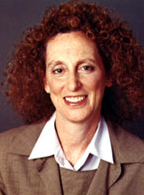 Dr. Gaines-Ross is one of the world’s most widely recognized experts on CEO reputation — how CEO reputations are built, enhanced and protected. She spearheaded the first comprehensive research on CEO reputation and its impact on corporate reputation and performance. She developed Weber Shandwick’s first global corporate reputation study — “Safeguarding Reputation™,” which identifies strategies for sustaining and recovering corporate reputation. Dr. Gaines-Ross is the author of CEO Capital: A Guide to Building CEO Reputation and Company Success (John Wiley & Sons, 2003) and Corporate Reputation: 12 Steps to Safeguarding and Recovering Reputation (www.corporatereputation12steps.com, John Wiley & Sons, 2008).
Dr. Gaines-Ross is one of the world’s most widely recognized experts on CEO reputation — how CEO reputations are built, enhanced and protected. She spearheaded the first comprehensive research on CEO reputation and its impact on corporate reputation and performance. She developed Weber Shandwick’s first global corporate reputation study — “Safeguarding Reputation™,” which identifies strategies for sustaining and recovering corporate reputation. Dr. Gaines-Ross is the author of CEO Capital: A Guide to Building CEO Reputation and Company Success (John Wiley & Sons, 2003) and Corporate Reputation: 12 Steps to Safeguarding and Recovering Reputation (www.corporatereputation12steps.com, John Wiley & Sons, 2008).
Before joining Weber Shandwick, Dr. Gaines-Ross was Chief Knowledge & Research Officer Worldwide at Burson-Marsteller and Marketing & Communications Director at Fortune. At Fortune, she initiated several groundbreaking research programs including “Leveraging Corporate Equity” and “Brands at the Crossroads.” She is also widely recognized for her strategic insights into and analysis of Fortune’s Most Admired Companies Survey. Dr. Gaines-Ross was a 1995 winner of Time Inc.’s President’s Award. She is also the co-author of FORTUNE Cookies: Management Wit and Wisdom, which was published by Vintage Books.
Dr. Gaines-Ross’ work has been featured in the Financial Times, The Times (London), The Wall Street Journal, The New York Times, The Economist, Fortune, BusinessWeek, Wired, Advertising Age, PRWeek, Forbes, The Christian Science Monitor, USA Today, Chief Executive, Business 2.0, Across the Board and in many other publications around the world. She has also appeared on CNN and CNBC.
Dr. Gaines-Ross is a frequent public speaker on CEO and corporate reputation management. She has lectured at The Anderson Graduate School of Management at UCLA, USC, Wharton School of Business, New York University and Columbia University. Dr. Gaines-Ross was also a speaker at the 2003 World Economic Forum Governor’s Meeting. She is a member of Ethical Corporation’s Advisory Board, serves on the Executive Advisory Panel of Corporate Reputation Review and was inducted into the Academy of Women Achievers of the YWCA of the City of New York. Dr. Gaines-Ross has been named one of the “100 Most Influential People in Business Ethics for 2007” by Ethisphere Magazine.
Dr. Gaines-Ross created http://www.reputationRx.com, the Web site devoted exclusively to reputation news and information, and her blog can be found at http://www.reputationXchange.com.
Who should purchase:
- Corporate communications, marketing and public relations professionals Executives at all levels and areas of the company who need to understand the new “stumble-rate” of corporate reputations, and be prepared with a realistic roadmap to reputation recovery that can stabilize and regenerate a company’s most competitive asset.
For more than two decades, through his ongoing study, The Search for a Simpler Way, Bill Jensen has been researching how our managers and workforce communicate with each other.
In the past few years, something critical has happened: They have hacked our capabilities.
They can do what we do. Often, better than we can. How do we leverage that, instead
of fighting it? How can we learn from them?
Two-way communication means listening to what the workforce has to tell us. If you are
interested in learning from them, this is the most crucial webinar you will attend all year!
What You Will Learn:
- What benevolent hacking is, and how we are being hacked
- How companies waste massive amounts of time and energy…
and how we are complicit in this act - The top three things you should be doing to save your
organization from itself - Practical tips for getting started, and getting praise from above
Who Should Attend
This webinar ideal for communicators with:
- VPs, Directors and managers of internal communications, social media, marketing,
corporate communications, public relations, and branding - Anyone responsible for integrating external communications — marketing, sales, customer service, branding, etc. — with internal change efforts
Presented by:
 Bill Jensen is today’s foremost expert on work complexity and cutting through clutter to what really matters. He has spent the past two decades studying how work gets done. (Much of what he’s found horrifies him.) Known as Mr. Simplicity for his first book, Bill has written five best-selling books based on his research. His latest, Hacking Work, was hailed as one of 2010’s Top Ten Breakthrough Ideas by Harvard Business Review. It reveals an underground army of benevolent hackers — breaking all sorts of rules so everyone can do great work. Bill is CEO of The Jensen Group: his list of clients includes the top companies in the world and he is constantly on the road, speaking in places from tech-shops in San Fran to sweatshops in Asia to palaces in Europe. Most importantly: Bill’s personal life fantasy is to bicycle around the globe via breweries.
Bill Jensen is today’s foremost expert on work complexity and cutting through clutter to what really matters. He has spent the past two decades studying how work gets done. (Much of what he’s found horrifies him.) Known as Mr. Simplicity for his first book, Bill has written five best-selling books based on his research. His latest, Hacking Work, was hailed as one of 2010’s Top Ten Breakthrough Ideas by Harvard Business Review. It reveals an underground army of benevolent hackers — breaking all sorts of rules so everyone can do great work. Bill is CEO of The Jensen Group: his list of clients includes the top companies in the world and he is constantly on the road, speaking in places from tech-shops in San Fran to sweatshops in Asia to palaces in Europe. Most importantly: Bill’s personal life fantasy is to bicycle around the globe via breweries.
Bottom line, intranets are simply business tools, and that means they must pay their way. It also means intranet managers must be on a perpetual quest to find ways to justify the investment in the intranet and prove its value. So how do you know your intranet is any good? What is the latest thinking on intranet measurement? In this webinar, one of the world’s most experienced intranet experts describes 15 simple yet solid ways you and your team can measure your intranets impact. Using these techniques will help you better able to justify new investments to your senior management. Attend with your governance team so that everyone is on the same page. This seminar is based on a chapter of Martin’s forthcoming book, The Intranet Governance Handbook, which is due out at the end of the year.
Learning Topics:
- How to make sense of web logs and avoid some pitfalls in analyzing them
- How to use search statistics to make better decisions about resources and usability
- How to ask survey questions about your intranet that will give you valuable information
- How to add feedback forms that provide continuous ideas for improvement
 Martin White is Managing Director of Intranet Focus Ltd. and consults on the design and management of intranets, the development of enterprise information management strategies, and the implementation of content management and enterprise search software. He has been a Visiting Professor at the Department of Information Studies, University of Sheffield since 2002 and is also a member of the Publications Board of the Royal Society of Chemistry. Martin is a Fellow of the Royal Society of Chemistry and an Honorary Fellow of the Chartered Institute of Library and Information Professionals and is currently Chairman of the UK Electronic Information Group. Martin is the author of the Eureka column on enterprise search issues for EContent magazine, for which he is a Contributing Editor. He was Chairman of the Online Information Conference from 1999-2006 and is the author of The Content Management Handbook and Making Search Work, both published by Facet Publishing, and (with Stephen Arnold) Successful Enterprise Search Management published by Galatea. His new book, The Intranet Governance Handbook, will be published by Facet at the end of the year. His consulting career spans 30 countries and a temperature range from -15C to 42C (5F to 107F).
Martin White is Managing Director of Intranet Focus Ltd. and consults on the design and management of intranets, the development of enterprise information management strategies, and the implementation of content management and enterprise search software. He has been a Visiting Professor at the Department of Information Studies, University of Sheffield since 2002 and is also a member of the Publications Board of the Royal Society of Chemistry. Martin is a Fellow of the Royal Society of Chemistry and an Honorary Fellow of the Chartered Institute of Library and Information Professionals and is currently Chairman of the UK Electronic Information Group. Martin is the author of the Eureka column on enterprise search issues for EContent magazine, for which he is a Contributing Editor. He was Chairman of the Online Information Conference from 1999-2006 and is the author of The Content Management Handbook and Making Search Work, both published by Facet Publishing, and (with Stephen Arnold) Successful Enterprise Search Management published by Galatea. His new book, The Intranet Governance Handbook, will be published by Facet at the end of the year. His consulting career spans 30 countries and a temperature range from -15C to 42C (5F to 107F).
“Great use of my time since the presenter answered a lot of my questions and gave me new thought starters for my team.”
 Ebay: Engaging Employees in Innovative Social Responsibility Projects
Ebay: Engaging Employees in Innovative Social Responsibility Projects
Amy Skoczlas Cole, Director, eBay Green Team
Amy Skoczlas Cole has worked at the nexus of business and sustainability for 15 years. As a thought leader in embedding authentic and strategic corporate responsibility programs into business operations, Amy has advised dozens of Fortune 500 companies. Her expertise covers a myriad of CSR issues, including greening operations and supply chains, creatively engaging customers and employees in environmental efforts, and partnering effectively with stakeholder communities.
Today, as the Director of the eBay Green Team at eBay Inc., Amy leads eBay’s efforts to engage their 88 million active users in making more sustainable buying choices that both can save consumers money as well as help protect the planet. Building off a grassroots efforts started by eBay’s own employees, the eBay Green Team is a community of over 100,000 people who have pledged to be smarter, greener buyers and sellers. Launched in March of 2008, the eBay Green Team has focused on raising awareness of the environmental benefits of using products that already exist today, and demonstrated how small actions can collectively add up to a big difference. Within eBay, the employee Green Team, which numbers over 2,000 employees in 23 countries, has spearheaded a number of projects to make eBay a greener company, from developing alternative commute programs to planting the first ever Fortune 500 company sponsored community garden. In her role, Amy also serves as on the company’s Sustainability Steering Committee, the executive body empowered by eBay CEO John Donahoe to set and implement eBay’s own operational commitments, including installing the city of San Jose, Calif.’s largest solar installation, building eBay’s newest building to LEED Gold standards, and most recently, announcing a commitment to reducing eBay’s greenhouse gas emissions by an ambitious 15% by 2012 over 2008.
Prior to joining eBay in early 2008, Amy was a co-founder and Vice President of Conservation International’s Center for Environmental Leadership in Business. For well over a decade, she engaged business leaders across a wide range of industries in creating strategic sustainability programs that benefited the global environment and the bottom line. In that role, she led multinational companies through the process of understanding, measuring, mitigating, and offsetting their environmental footprint and that of their supply chain – and in doing so, creating leadership brand enhancement and marketing opportunities. Amy applied this expertise during three years in Rio de Janeiro, Brazil, where she helped to found a Brazilian sustainability organization focused on engaging Brazilian companies in environmental efforts. A seasoned expert in crafting partnerships between the business and non-profit communities, Amy launched relationships with companies as diverse as Starbucks, Wal-Mart, McDonald’s, Vale do Rio Doce, Intel, Petrobras, Office Depot, Aracruz Celulose, Fiji Water and Bank of America.
Amy holds an MBA in marketing and finance from George Washington University, and a BA in Environmental Policy from Vanderbilt University. She is the author of various articles on business and sustainability issues, and a frequent speaker at national and international events, conferences and business schools. She is the associate editor of Footprints in the Jungle, a book about natural resource companies and the environment. Amy serves on the advisory boards of the Brazilian sustainability organization Instituto BioAtlantica, and Climate Earth, an enterprise carbon accounting start up. She lives in the San Francisco Bay area with her husband and son.
We are living in an era where social media not only impacts the way human beings interact with one another, but is influencing business decisions and customers’ perceptions of brands. By making employees confident in the fact that they can reach out to customers and by providing them with the necessary resources, you grow your external reach exponentially.
The Social Media Ninjas team at Sprint has done just that with their award winning employee advocacy program. Through the implementation of a training program that gives a fly-by of the corporation’s social media policy along with placing strong employee-facing support resources in a variety of channels, Sprint has created a program that drives employee engagement while protecting and enhancing its brand reputation.
Find out how internal communications is your best fuel for active advocacy and why a too formal social media policy can actually deter employees from joining your force. You’ll see how Sprint empowers its employees with real-time, company-approved, social media updates.
What You Will Learn:
- How to align internal communications and social media goals
- How to create a winning cross-functional team
- How to communicate a policy that works for advocates and Legal
- What motivates employees to participate voluntarily
- What resources you can put in place to optimize success
- Various channel to stay connected with your employee advocates
- The effect that extra reach can have on your organization
Presented by:
 Jennifer Sniderman, Group Manager – Employee Communications leads news, editorial and social media for enterprise-wide employee communications at Sprint. She specializes in interactive multimedia engagement programs which have garnered numerous awards. Jennifer is the co-creator of Sprint’s Social Media Ninja program leveraging employee advocacy to bolster the customer experience and improve Sprint’s corporate reputation. She provides counsel to Sprint’s Human Resources team to deliver leader-focused communications programs. Prior to joining Sprint, she was Assistant Vice President, Corporate Communications at Zurich Scudder Investments in Chicago, IL. Outside of work, she serves on the board of Chameleon Arts & Youth Development, a non-profit organization providing arts education for homeless and under-served children.
Jennifer Sniderman, Group Manager – Employee Communications leads news, editorial and social media for enterprise-wide employee communications at Sprint. She specializes in interactive multimedia engagement programs which have garnered numerous awards. Jennifer is the co-creator of Sprint’s Social Media Ninja program leveraging employee advocacy to bolster the customer experience and improve Sprint’s corporate reputation. She provides counsel to Sprint’s Human Resources team to deliver leader-focused communications programs. Prior to joining Sprint, she was Assistant Vice President, Corporate Communications at Zurich Scudder Investments in Chicago, IL. Outside of work, she serves on the board of Chameleon Arts & Youth Development, a non-profit organization providing arts education for homeless and under-served children.
 Sara Folkerts, Internal Social Media Manager is passionate about sharing, communicating, transparency and being open-minded. This has led her to her current job as a community manager and social media evangelist at Sprint. In addition to her role as community manager, Sara co-leads the Ninjas program at Sprint. Sara has presented on internal social media strategies at several conferences and at other companies. Where can you find her? On Twitter, of course! @saramiller.
Sara Folkerts, Internal Social Media Manager is passionate about sharing, communicating, transparency and being open-minded. This has led her to her current job as a community manager and social media evangelist at Sprint. In addition to her role as community manager, Sara co-leads the Ninjas program at Sprint. Sara has presented on internal social media strategies at several conferences and at other companies. Where can you find her? On Twitter, of course! @saramiller.
 Nic Lazowski, Communication Specialist is driven to engage employees and deliver information that will result in action. His role is centered around employee involvement and advocacy. As a Communication Specialist for Sprint, Nic is responsible for helping to drive employee education and advocacy through social media with other members of the Social Media Ninjas lead team.
Nic Lazowski, Communication Specialist is driven to engage employees and deliver information that will result in action. His role is centered around employee involvement and advocacy. As a Communication Specialist for Sprint, Nic is responsible for helping to drive employee education and advocacy through social media with other members of the Social Media Ninjas lead team.
Who Should Attend
- This webinar will cater to individuals who recognize the growing need for immediate and far-reaching contact with customers and potential customers. The information provided will allow you to start making your organization more nimble and approachable while improving reputation among customers.
Webinar attendee: “I appreciated all the information on how to put together a social media program for employees; the tools to use, the benefits of involving employees, how to set up the training program, etc.”
So often communicators surrender to time and budget challenges jumping into tactics or solutions without ever conducting a complete communications assessment. But without a baseline, it is nearly impossible to measure the success of ones efforts. It is also more challenging to demonstrate ones strategic abilities. Thus, communicators cannot afford to not conduct a complete communications assessment.
What You Will Learn:
- Why it is crucial for communicators to take time out to conduct a communications assessment and understand business needs.
- What formal and informal communications assessment tools/tactics will support your time and budget.
- How much time and budget is required to support formal and informal communications assessment tools/tactics.
- How to effectively communicate your assessment findings.
- How to leverage your findings to create a solid communication strategy and plan.
- What lessons can be learned from real world communications assessments conducted for NEC, Adidas-Solomon, UOP, ServiceMaster and other leading organizations.
Who Should Attend
This session is perfect for any level of experience, from those who are just starting in the field or those who have never conducted an assessment, to seasoned communication veterans.The seminar is designed for communication professionals who want to take their programs to the next level or arm themselves to move from tactician to strategic planner. Size of organization does not matter. It is especially suitable for individuals in:
- Internal and Corporate Communications
- Public relations
- Media Relations
- Public Affairs
- Marketing
- Small and mid-sized business leaders
- Corporate executives who are new to communication and measurement
Presented by:
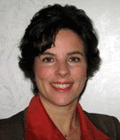 Julie Baron is Principal of COMMUNICATION WORKS. She has over 18 years of communications experience. Julie is a resourceful communications strategist with demonstrated ability to work internally within the organization, as well as externally within the community. Her functional expertise includes executive/employee communications, speech writing, cultural awareness and marketing communications.With a proven track record of positively impacting financial and operating results through communication, Julie’s client list includes Abbott, adidas-Salomon, HUB International, National Association of Realtors, Revell, and Pepsi Americas. Prior to opening the doors of COMMUNICATION WORKS, Julie held senior level communications positions for NEC Technologies, Inc. and Motorola, Inc. She also has agency experience.Julie has published several communication and training articles and has lectured on communications topics including CEO communication, culture development, global communication and internal marketing. She’s been recognized for her leadership abilities, team focus, creative strategy, execution and effective working relationships.An active member of the International Association of Business Communicators (IABC), Julie has held many volunteer leadership positions including president of the IABC/Chicago chapter, the association’s second largest chapter worldwide. Julie graduated from Northwestern University in Evanston, Illinois, with a master’s degree in communications. She holds a bachelor’s degree in broadcasting from SUNY Buffalo.
Julie Baron is Principal of COMMUNICATION WORKS. She has over 18 years of communications experience. Julie is a resourceful communications strategist with demonstrated ability to work internally within the organization, as well as externally within the community. Her functional expertise includes executive/employee communications, speech writing, cultural awareness and marketing communications.With a proven track record of positively impacting financial and operating results through communication, Julie’s client list includes Abbott, adidas-Salomon, HUB International, National Association of Realtors, Revell, and Pepsi Americas. Prior to opening the doors of COMMUNICATION WORKS, Julie held senior level communications positions for NEC Technologies, Inc. and Motorola, Inc. She also has agency experience.Julie has published several communication and training articles and has lectured on communications topics including CEO communication, culture development, global communication and internal marketing. She’s been recognized for her leadership abilities, team focus, creative strategy, execution and effective working relationships.An active member of the International Association of Business Communicators (IABC), Julie has held many volunteer leadership positions including president of the IABC/Chicago chapter, the association’s second largest chapter worldwide. Julie graduated from Northwestern University in Evanston, Illinois, with a master’s degree in communications. She holds a bachelor’s degree in broadcasting from SUNY Buffalo.
 Sean Williams is the owner of Communication AMMO, Inc. He helps leaders improve their communication skills, build strategic communication plans, strengthen internal communication capabilities and effectively measure the results. His clients include the Federal Reserve Bank of Cleveland and KeyBank. Follow him on Twitter at @CommAMMO.
Sean Williams is the owner of Communication AMMO, Inc. He helps leaders improve their communication skills, build strategic communication plans, strengthen internal communication capabilities and effectively measure the results. His clients include the Federal Reserve Bank of Cleveland and KeyBank. Follow him on Twitter at @CommAMMO.
Most recently, Williams was vice president of Corporate Communications for a financial institution, leading the internal communication, and internal and external public relations measurement and evaluation functions during the height of the financial crisis.
Previously, he was manager of Editorial Services for The Goodyear Tire and Rubber Company, responsible for internal communication and video production, photography and event production management. While at Goodyear, Williams lead the team rebuilding the corporate intranet, using editorial content from around the world. He also served as the primary internal communication consultant to the company’s senior leadership and produced videos and still photography for a variety of external and internal constituencies.
 Susan D’Alexander, ABC, is Senior Communications Consultant at Motorola Global Communications. Susan has a 25-year career with Motorola with more than 18 years experience in communication management, including corporate, HR, marketing and corporate social responsibility communications. Susan is a member of the International Association of Business Communicators (IABC) earning an accredited business communicator (ABC) certification in 2008. She holds a Bachelor of Science degree from Western Illinois University and a MBA from Roosevelt University, Chicago, Illinois.
Susan D’Alexander, ABC, is Senior Communications Consultant at Motorola Global Communications. Susan has a 25-year career with Motorola with more than 18 years experience in communication management, including corporate, HR, marketing and corporate social responsibility communications. Susan is a member of the International Association of Business Communicators (IABC) earning an accredited business communicator (ABC) certification in 2008. She holds a Bachelor of Science degree from Western Illinois University and a MBA from Roosevelt University, Chicago, Illinois.
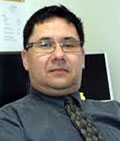 Alex Vass has been a communicator, telling stories and creating messages, all of his working life. He is presently a communications advisor with the Royal Canadian Mounted Police responsible for internal and external communications for the Codiac Regional RCMP detachment based in Moncton, New Brunswick. He along with his fellow RCMP communications colleagues in New Brunswick recognized the need for a
Alex Vass has been a communicator, telling stories and creating messages, all of his working life. He is presently a communications advisor with the Royal Canadian Mounted Police responsible for internal and external communications for the Codiac Regional RCMP detachment based in Moncton, New Brunswick. He along with his fellow RCMP communications colleagues in New Brunswick recognized the need for a
communications audit to demonstrate to senior management the value communications has within the organization and how communications must become part of the organization’s core business. The RCMP in New Brunswick is now on a path towards doing just that. Prior to joining the RCMP in 2005, Alex spent over 25 years as a journalist in Atlantic Canada, 16 years of which was as a reporter with the CTV television
network.
Presentation from Essential Social Media Skills Practicum at Georgia Institute of Technology

When it comes to humanizing your brand in social media, nobody can do it better than your employees. The 2010 Edelman Trust Barometer found “conversations with employees” remain one of the most credible sources of information about a company – ahead of news coverage, online search, or ads.
Pepsico is one company that has done the social media math. On Facebook alone, average users have 130 friends. Multiply that times Pepsico’s 300,000 employees and you have potentially millions of trusted conversations.
With that vision, Sharon McIntosh, senior director of global internal communications at PepsiCo, set out last year on a methodical process to empower employees to share their pride in the company on their social networks. In the process, the PepsiCo intranet has become a key platform for delivering and tagging the content that gets shared outside.
In this unique webinar, Sharon will share her journey to empower employees to be social media brand ambassadors. It has taken a balanced combination of tools, trust. Every company needs to figure this out – get a head start by attending this important webinar with your team.
What You Will Learn:
- Where you should start; who needs to be onboard
- How do you sell a social ambassador program to management, and employees
- How do you create a voluntary, online training program to educate employees on engaging in conversations that are authentic, responsible and interesting.
- How do you decide on the right content for employees to share – and a seamless process to make sharing easy
- How to make sure your social media policy doesn’t scare employees away
- What about incentives?
Presented by:
 Sharon McIntosh is senior director of Global Internal Communications for PepsiCo, overseeing the internal strategy and channels for the company’s nearly 300,000 associates. She previously worked in internal communications, corporate communications, marketing and media relations at a range of companies, including Sears, Waste Management and the Illinois Hospital Association. Connect with Sharon on Twitter: @mcintoshs.
Sharon McIntosh is senior director of Global Internal Communications for PepsiCo, overseeing the internal strategy and channels for the company’s nearly 300,000 associates. She previously worked in internal communications, corporate communications, marketing and media relations at a range of companies, including Sears, Waste Management and the Illinois Hospital Association. Connect with Sharon on Twitter: @mcintoshs.
Who Should Attend
- Social media is a team sport. Business professionals from all of these departments have a key role to play and should attend this webinar, preferably as a group: internal communications, HR ,marketing, corporate communications, public relations, customer service, legal and media relations.
“Excellent information … Great job Sharon!!”
You understand the incredible transformative power of social media in the hands of millions of users. You know that a properly executed strategy can propel your firm well past the competition in the hearts and minds of your consumers. But how do explain all of this to your boss? In this engaging and informative seminar, leading social media practitioner Maggie Fox will share her numerous experiences in getting corporate buy-in at the highest levels, giving you the understanding and ammunition you need to get the Web 2.0 ball rolling within your firm.
Learning Topics:
- Statistics and Usage
- Best Practices/Case Studies/Benefits
- Metrics, Measurements and ROI
- Risks/Risk Management
- Resource Requirements/Planning for Success
Questions that
will be answered:
- The numbers – bosses may not know social media, but they know numbers. We’ll talk about how many people use web 2.0 tools and platforms and provide you with the ammunition you need to provide context and justification for your social media plans.
- Who’s doing what? Using practical facts and case studies we’ll examine emerging best practices and give you examples of how companies have successfully leveraged social media.
- How can you measure the success of a social media program? There are no metrics “formulas”, but we’ll talk about setting benchmarks, measuring engagement and touch on the idea of calculating ROI
- The risks – what are they, and what do you need to be careful of? How can you neutralize them? Do’s and don’ts.
- Resources – using real-world examples, we’ll talk about basic resource requirements and how planning ensures success.
- Open Q&A – bring your questions. There will be an open Q&A session following the formal presentation.
Presented by:
 Maggie Fox, founder of Social Media Group, Canada’s first agency devoted exclusively to helping business navigate the world of Web 2.0, is a communications and content expert who has never met a medium she didn’t like. Over the course of her career, she’s marketed, written and produced television content for some of the biggest and best-known brands in North America, including Sears, Deloitte and Disney.
Maggie Fox, founder of Social Media Group, Canada’s first agency devoted exclusively to helping business navigate the world of Web 2.0, is a communications and content expert who has never met a medium she didn’t like. Over the course of her career, she’s marketed, written and produced television content for some of the biggest and best-known brands in North America, including Sears, Deloitte and Disney.
Pioneers in their field, Social Media Group has created and implemented successful Web 2.0 strategies for major firms like Yamaha Motor and Harlequin Publishing, and Maggie often speaks to the press and business groups about the importance and use of social media in the enterprise. Read the Social Media Group blog.
Because they have access to the tools that personally connect them to their friends, family and peers, employees are jeopardizing their organization’s brand stature, reputation and competitive edge, often without realizing it. Without thinking, employees are sharing candid and damaging thoughts and updates — intentionally and unintentionally – that possess an uncanny ability to surface when least expected and be discovered by people who were never supposed to see them in the first place. And, perhaps accidentally, employees are sharing company secrets and information that should never see the light of day, and are doing so simply because they aren’t aware of the reach and power they have on the social web. This CD is aimed at helping corporate communication, marketing and PR professionals understand and lead their organization’s into the new world of online engagement, where the most operative rule may be simply: Don’t be stupid.
“I have attended a few “freebie” classes from other services, but found yours to be much more informative on the action side. Giving real life, no kidding ideas on how to do things.”
“Very informative and worthwhile. The speaker was articulate and knowledgeable and made me think.”
What You Will Learn:
- What are the absolute rules of engagement that all your employees should know
- Social media horror stories and some policies to avoid them
- Building marketing and service teams around social media programs
- Top 10 guidelines for social media participation
- Teaching employees to talk: it’s not only what you say, it’s how you say it
- Who answers what … the best processes to manage brand conversations
- New roles and responsibilities in the era of emerging media
- How to guide the rise and evolution of social media in your organization
Presented by:
 Brian Solis is globally recognized as one of most prominent thought leaders and published authors in new media. A digital analyst, sociologist, and futurist, Solis has influenced the effects of emerging media on the convergence of marketing, communications, and publishing. He is principal of FutureWorks, an award-winning New Media agency in Silicon Valley, and has led interactive and social programs for Fortune 500 companies, notable celebrities, and Web 2.0 startups. BrianSolis.com is ranked among the top of world’s leading business and marketing online resources.
Brian Solis is globally recognized as one of most prominent thought leaders and published authors in new media. A digital analyst, sociologist, and futurist, Solis has influenced the effects of emerging media on the convergence of marketing, communications, and publishing. He is principal of FutureWorks, an award-winning New Media agency in Silicon Valley, and has led interactive and social programs for Fortune 500 companies, notable celebrities, and Web 2.0 startups. BrianSolis.com is ranked among the top of world’s leading business and marketing online resources.
Brian’s newest book is Engage! The Complete Guide for Brands and Businesses to Build, cultivate and Measure Success in the New Web.
Solis along with co-author Deirdre Breakenridge released Putting the Public back in Public Relations in 2009. Published by Financial Times Press, the book has become a best seller and is highly regarded a must read by anyone in marketing, communications, and also journalism.
In concert with Geoff Livingston, Solis released Now is Gone in 2007, an early, award-winning book that helps businesses learn how to engage in Social Media. He has also written several ebooks on the subjects of Social Media, New PR, Customer Service, and Blogger Relations.
Social media poses some important new challenges for the internal communicator. On the one hand, the influx of new communications platforms has the potential of transforming how organizations work and communicate. On the other hand, as conversation channels expand and are available to everyone in an organization, how do you keep key messages from being diluted, and the corporate culture intact? Bottom line, what should the role of internal communications be in the age of social media? This panel continues the opening keynote discussion started at the Communitelligence Employee Engagement, HR & Social Media 2010 Conference in Chicago. Join this critical conversation and make sure you and your program stay relevant in this new age of internal communications.
Learning Topics:
- Key steps to ensure you and your department remain relevant and have the right impact.
- The role you should be playing: what is new and what remains the same
- Why clarity of message has become more critical with the decentralization of communication.
- What key skills communicators have that are the best antidote to obsolescence
- What are the best antidotes to obsolescence?
- “Excellent session! Worth the time investment!”
- Excellent high-level view”
- “I learned how important it is to know your intenal audience.”
- “The Avoiding Extinction piece by Cathi Killian was great.”
- “The greatest single benefit was learning about specific tools that were being using by other companies such as Yammer for “employee jams” and thinking like an intern by hiring a teenager.”
Presented by:

Gary F. Grates is President/Global Managing Director of Edelman Change and Employee Engagement, the organizational communications counseling practice of Edelman, the world’s largest independent public relations/communications counseling firm and the third largest overall. He has more than 25 years of corporate, marketing/brand, labor, and strategic communications experience with a particular expertise in change management/employee (internal) communications. Grates has counseled more than one hundred organizations including PepsiCo, Starbucks, Guardian, General Motors, Volvo, Nissan, Caterpillar, Shell, Visa International, Coca-Cola, Wal-Mart, British Airways, ITT, GE Healthcare, eBay, and Dell, to name a few. Prior to joining Edelman, he served as Vice President-Corporate Communications/North America at the General Motors Corporation. In this role, Grates was responsible for brand, product, media, internal, financial and public policy communications for GM’s North America Region, the largest in the company. He was also the global process leader for internal communications reporting to Chairman/CEO, G. Richard Wagoner, and a member of General Motors’ North American Strategy Board, the senior most governing body in North America. In addition, he was on the teaching staff at General Motors University (GMU) and selected to join the company’s exclusive Senior Executive Program – a leadership development program.
 Jill Feldon LaNouette is vice president of Internal Communications in the Public Affairs Department at Cardinal Health. In this capacity, she counsels senior executives in effective communication strategies and leads her team in developing and implementing communication plans and programs to support the company’s objectives. She also is responsible for crisis communications and issues management. Ms. LaNouette joined Cardinal Health in 2003 as director of Organizational Communication where she provided communication support on several major change initiatives and brand-building projects. In her 30 years of helping organizations effectively communicate with different constituencies, Ms. LaNouette has received numerous awards for marketing and communications from various organizations including the Gold Quill from the International Association of Business Communications and the Silver Anvil from the Public Relations Society of America. She has worked with companies from healthcare to Hollywood, including Victoria’s Secret, The Procter & Gamble Company, Kaiser Permanente, Lucasfilm Ltd., and public radio. Also Jill is a free-lance writer and consultant, has been published in several publications, and worked as a sports reporter for the Cincinnati Enquirer.
Jill Feldon LaNouette is vice president of Internal Communications in the Public Affairs Department at Cardinal Health. In this capacity, she counsels senior executives in effective communication strategies and leads her team in developing and implementing communication plans and programs to support the company’s objectives. She also is responsible for crisis communications and issues management. Ms. LaNouette joined Cardinal Health in 2003 as director of Organizational Communication where she provided communication support on several major change initiatives and brand-building projects. In her 30 years of helping organizations effectively communicate with different constituencies, Ms. LaNouette has received numerous awards for marketing and communications from various organizations including the Gold Quill from the International Association of Business Communications and the Silver Anvil from the Public Relations Society of America. She has worked with companies from healthcare to Hollywood, including Victoria’s Secret, The Procter & Gamble Company, Kaiser Permanente, Lucasfilm Ltd., and public radio. Also Jill is a free-lance writer and consultant, has been published in several publications, and worked as a sports reporter for the Cincinnati Enquirer.
 Cathi Killian is Vice President, Internal Communications at Walt Disney Company. In her role leading internal communications and corporate responsibility, Cathi is responsible for enhancing the reputation of the Walt Disney Parks and Resorts through strategies driven by excellence in internal communications, stakeholder engagement and community outreach. She develops the strategic plan for Walt Disney Parks and Resorts internal communications, which leverages communication to reinforce our values and brand and foster the visibility of executive leadership. She works with the internal communications teams at each business unit in taking an integrated approach to delivering relevant information to inform, motivate and engage Cast Members, Crew Members and Imagineers. Additionally, she leads our efforts focused on issues management and stakeholder engagement to identify issues, track trends and understand the impacts to our business, while developing allies that support our goals.
Cathi Killian is Vice President, Internal Communications at Walt Disney Company. In her role leading internal communications and corporate responsibility, Cathi is responsible for enhancing the reputation of the Walt Disney Parks and Resorts through strategies driven by excellence in internal communications, stakeholder engagement and community outreach. She develops the strategic plan for Walt Disney Parks and Resorts internal communications, which leverages communication to reinforce our values and brand and foster the visibility of executive leadership. She works with the internal communications teams at each business unit in taking an integrated approach to delivering relevant information to inform, motivate and engage Cast Members, Crew Members and Imagineers. Additionally, she leads our efforts focused on issues management and stakeholder engagement to identify issues, track trends and understand the impacts to our business, while developing allies that support our goals.

